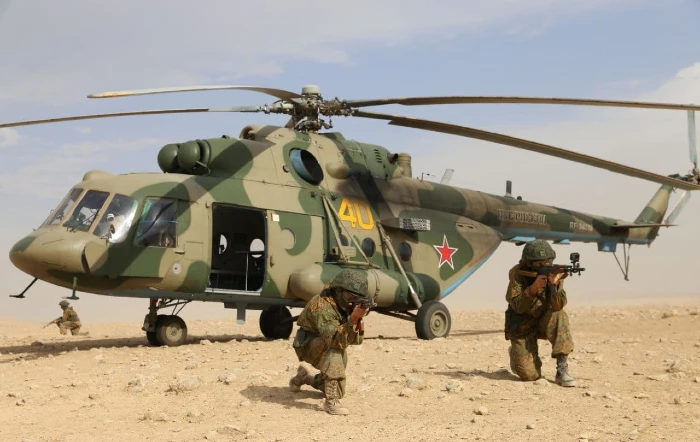The large-scale operational and strategic exercises of the collective forces of the Collective Security Treaty Organization (CSTO) concluded in south Tajikistan on Saturday with the military contingents conducting an operation to "destroy militants rapidly crossing the border from Afghanistan and invading the territory of a CSTO member state" in the final stage.
Exercises 'Echelon', 'Search' and 'Interaction' began on October 18 at the Harbmaidon and Momirak training grounds in the Khatlon region just 20 kilometers from the Tajik-Afghan border as part of 'Combat Brotherhood-2021' – the joint operational-strategic exercises of the CSTO.
Colonel-General Alexander Lapin, the commander of Russia's Central Military District, under whose guidance the exercises were conducted, expressed his satisfaction over the way one of the largest military exercises in the region was held to counter the challenges and threats emanating from the territory of Afghanistan after the return of Taliban.

"The completed large-scale exercises in Tajikistan with the Collective Rapid Reaction Forces of the CSTO became one of the most important responses to the sharp aggravation of the situation in Afghanistan. The conducted exercises are designed to protect the CSTO member states from any terrorist threat," Lapin said during the closing ceremony of the exercises today.
Russia to revamp strategic base in Tajikistan to counter Taliban's threat from Afghanistan
In total, over four thousand servicemen from Russia, Belarus, Kazakhstan, Kyrgyzstan, Armenia and hosts Tajikistan – all CSTO member states – and over 500 units of equipment were involved in the joint manoeuvres which began on Monday.
As servicemen performed joint actions to repel the attack of imaginary terrorists, they used the latest reconnaissance, electronic warfare, communications, logistical and medical support.
According to Lapin, an effective intelligence management system was deployed during the exercise, "which made it possible to reveal in advance the growing threats and thwart the plan of actions of the bandit formations."
Russia flaunts military might on Afghanistan's borders as CSTO military exercises begin

The Russian Defence Ministry revealed that a unified information battlefield was created during the exercises, which ensured the defeat of the enemy in hard-to-reach terrain in real time by using 19 new types of special equipment.
The Central Military District Commander said that the success of troops in defeating the invading bandit formations was ensured by surprise, lightning speed and decisive actions throughout the depth of the enemy grouping.
Central Asia frontline unites to confront Taliban on the Tajik-Afghan border
In the mountains, special forces and helicopter search assault groups were widely used. The actions of the raiding and outflanking detachments were continuously supported by operational-tactical and army aviation.
"The experience gained during the exercises will serve as a reliable guarantor of the fulfillment of tasks in a real combat situation," Lapin commented.
Intense final phase focused on 'destroying' Afghan militants
In the decisive final phase of the exercise, units of the Russian armed forces, together with the CSTO's Collective Rapid Reaction Forces (CRRF) completed the operation to destroy the "militants" who tried to enter the territory of the CSTO member state.
"At the beginning of the operation, a pair of L-39 aircraft of the Tajik Air Force, as well as a Russian Su-24 MR reconnaissance aircraft, conducted aerial reconnaissance of the area and found columns of 'militants' rapidly crossing the border from Afghanistan," said the headquarters of the exercises.
"To prevent their further advancement, special forces of the Russian and Tajik Armed Forces landed on Mi-8 helicopters, which ensured the advancement of the first echelon of the Collective Forces," it added.
The Russian and Tajik artillery forces were used to destroy the militants in cars using the "layer cake" method. As a result, the terrorists' off-road armoured vehicles were destroyed by anti-tank guided missiles.
The attack of unmanned aerial vehicles of the enemy was repelled by the anti-aircraft missile department of the "Verba" Manpads and the anti-aircraft artillery platoon ZU-23 of the Russian military base together with the anti-aircraft installations of the Armed Forces of Tajikistan.
To exclude the possibility of the enemy entering the rear of the advancing subunits, a tactical assault force of Belarusian and Kazakh subunits was landed by landing method.
"The tactical airborne assault was carried out by two pairs of Russian and Tajik transport and combat helicopters. A pair of Russian Mi-24 fire support helicopters and a pair of Tajik Mi-24 helicopters provided cover for a tactical airborne assault landing," the Russian military said.
Russian military reaches Afghanistan's border ahead of major exercise in Central Asia
As the sub-divisions of Russia, Tajikistan and Kyrgyzstan worked together to complete the rout of conventional illegal armed groups, the Russian Mi-24 helicopters provided fire support to the attacking units with the tactical 'helicopter carousel' technique which was used in Syria.
At the end of the practical actions, the Russian and Belarusian paratroopers entered the battle with the retreating enemy, blocking his withdrawal in the direction of the state border.
Also Read: Russia activates military base in Tajikistan as border tensions with Afghanistan rise




















